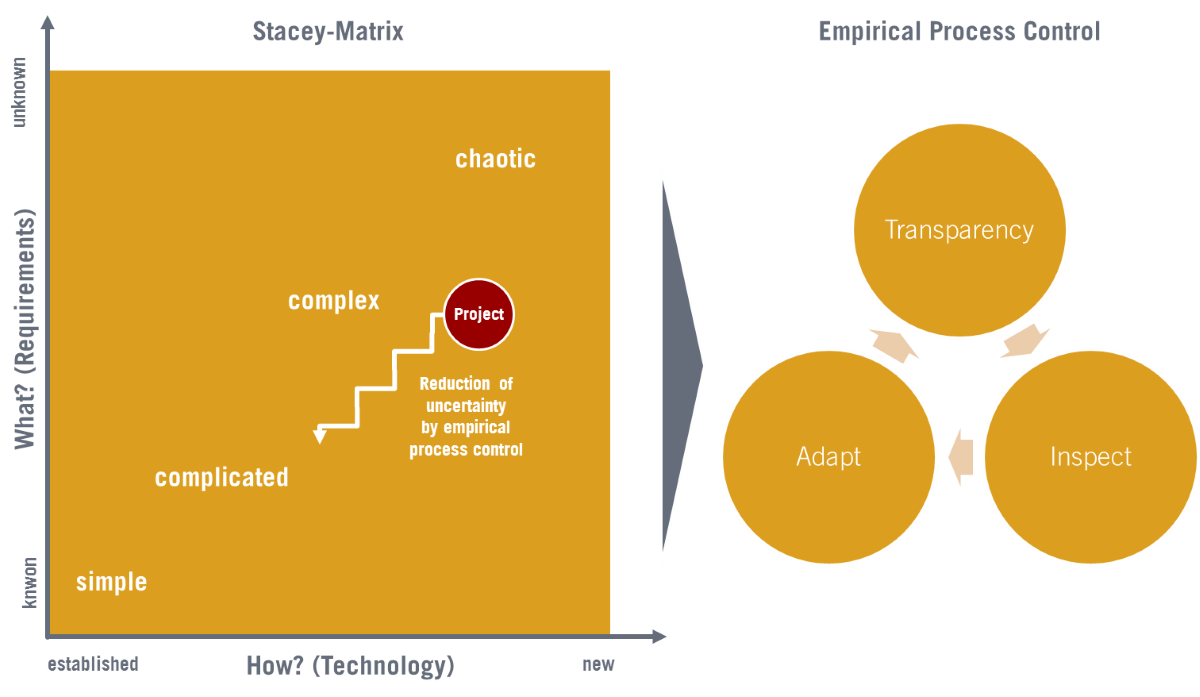Agile history and principles
By now, every manager in the field of product development has probably heard of the term “Scrum”. People like to associate it with software development and potentially also know that advantages can be gleaned in a fast-moving VUCA world with an iterative approach. On the other hand, many development managers are likely as yet not fully aware that Scrum has now also proven itself in the development of mechatronic products. And, no doubt, very few will know that Scrum or agile working has its origins precisely there, i.e. in the development of physical products.

The roots of Scrum
The roots of agile development cannot be clearly assigned. In the relevant literature, different contributions are cited as having played a role in its development. However, concerning two striking events, all sources largely agree that they had a decisive influence on the discipline of agility. One was the development of the P80 fighter jet at Lockheed Martin in 1943. And secondly, the publication of “The New New Product Development Game” by Hirotaka Takeuchi and Ikujiro Nonaka in the Harvard Business Review in 1986. It is interesting to note that both events had their focus on the development of mechatronic products. The focus on software development was only pronounced in the late 1990s by Jeff Sutherland and Ken Schwaber.
The iterative and incremental approach
In 1943, Kelly Johnson – a designer for the defence company Lockheed Martin – was given the task of developing a new fighter jet within 180 days. To achieve this goal, Johnson used a number of innovative methods. He had all the necessary specialists work together in one room – it was a tent. These specialists were allowed to organise their own work and were in regular contact with the users of the fighter jet, i.e. the customers. In addition, bureaucratic interference in the development process was minimised. The result was that the new P80 fighter jet was completed in 143 days.
NASA and IBM were the first large companies to systematically use the IID (Incremental Interative Development) method in the 1950s. With iterative teamwork and subsequent review phases in which the need for change was identified, the basic features of Scrum were defined. These approaches were strengthened and refined in the 1980s and 1990s through research and findings on organisational learning. The book “The Fifth Discipline - The Art and Practice of the Learning Organisations” by Peter M. Senge is a good example.
The Rugby Approach
Another important event was the publication of “The New New Product Development Game” by Hirotaka Takeuchi and Ikujiro Nonaka in the Harvard Business Review in 1986. Both of them had examined six product development projects and thereby worked out the superiority of what they called the “Rugby Approach” over the traditional waterfall approach. There, the term: “Moving the Scrum downfield” was coined for the first time. The results of this study ultimately served as the basis for the framework presented by Jeff Sutherland and Ken Schwaber at the OOPSLA conference in 1995, which they had developed together in the years before. The fact that this framework was based on the Rugby Approach also explains why they chose a term used in rugby as the namesake: SCRUM.
At that time, six success factors were identified:
- Inherent instability
- Self-organising project teams
- Overlapping development phases
- Multi-learning
- Discreet control
- Organisational transfer of learning
The agile manifesto
Agile development methods can thus be traced back to successful hardware projects, but were decisively developed further in software development in the mid-1990s. In 2001, 17 software developers met in Snowbird (Utah, USA) and expressed their common ideas and procedures in the agile manifesto. These four fundamental maxims still form the foundation of agile approaches today and can be applied equally to hardware and software development:
- individuals and interactions over processes and tools
- working software over comprehensive documentation
- customer collaboration over contract negotiaton
- responding to change over following a plan
© 2001, the Agile Manifesto authors
12 agile principles
The agile manifesto was further formulated with 12 principles. Read more at: https://www.agilealliance.org/agile101/12-principles-behind-the-agile-manifesto
Empirical process control
Agile development methods are better-suited for complex business fields and projects than classic waterfall processes and project management methods. Complex business fields and projects are characterised by a high degree of uncertainty regarding their market and customer requirements, as well as the technological solutions. Under these circumstances, empirical process control is superior to defined process control. Through a rapid sequence of the control loop: Create transparency, inspect development results and adapt solutions, while customer feedback on the current development status can be obtained and technical feasibility can be assured. In this way, it is possible to react quickly to changing customer needs. Uncertainty is continuously reduced, and a market-driven development result is achieved while maintaining a high level of development quality.
Agile principles go back to successful hardware projects
- As early as 1943, an incremental and iterative procedure was described for the first time in the development of a fighter jet.
- In the 1980s, Hirotaka Takeuchi and Ikujiro Nonaka studied six successful complex mechatronic development projects.
- They identified six success factors that are still the basis of agile development today.
- Later, agile methods were applied in software development.
- The agile manifesto describes four fundamental maxims of agile development from which 12 principles were derived.
- Empirical process control is superior to defined process control for complex business areas and projects.

